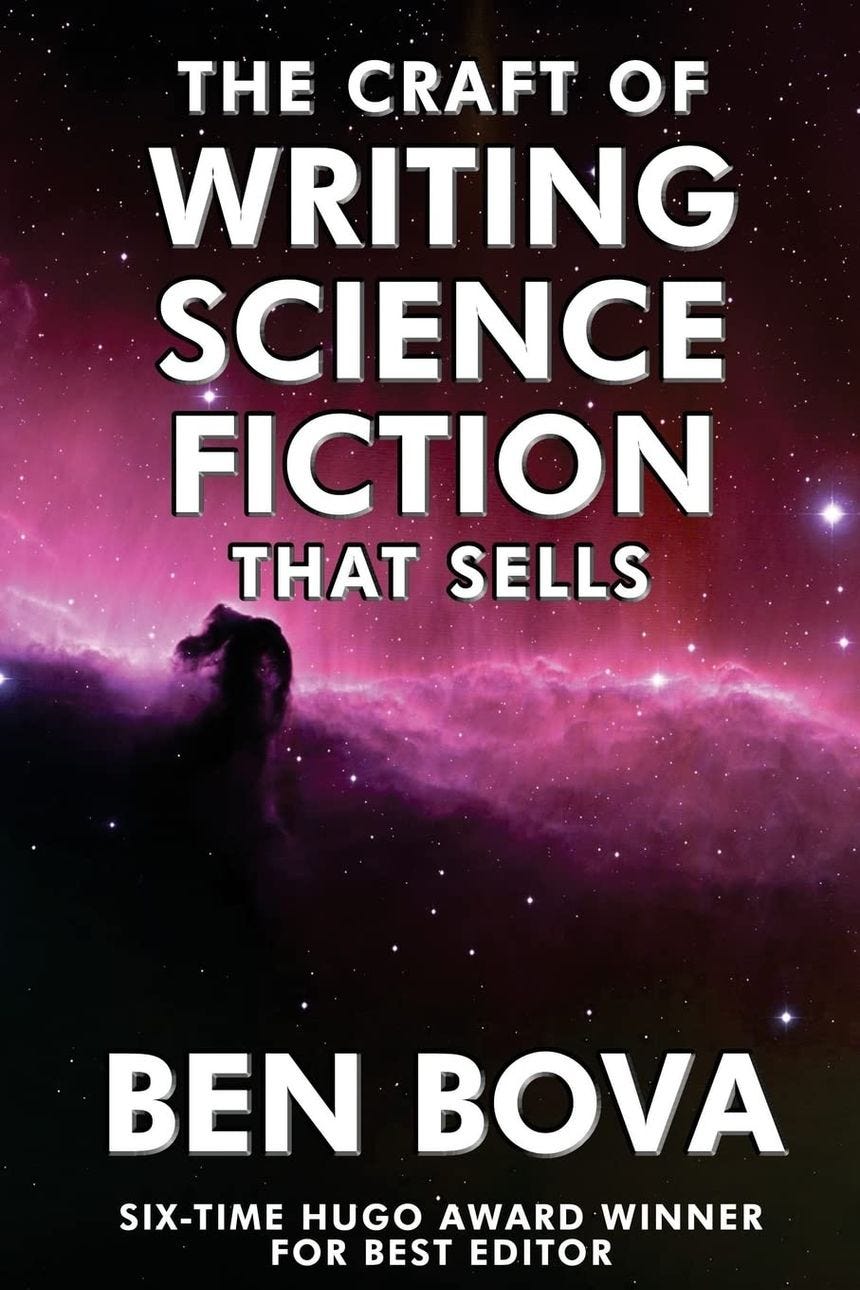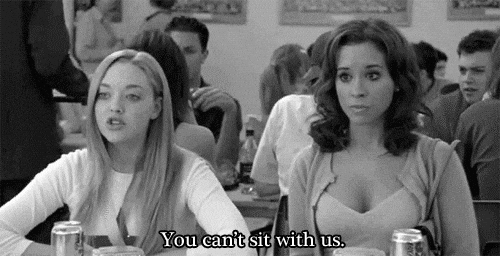Art & Craft: The Craft of Writing Science Fiction that Sells
Reviewing writing advice from Ben Bova
This post is part of Art & Craft, my series that reviews books about writing books.
Judging by the title alone, The Craft of Writing Science Fiction that Sells should be the most relevant book in this series when it comes to my own writing career. The back cover copy promises a step-by-step guide to following “rules” and “laws” which will make my work attractive to editors and spread my imagination to an exponential audience. You know, a nice, humble approach to breaking through in a rapidly evolving genre.
Why I chose this book
This was another impulse pick while I was shopping for other titles in this series–I noticed it because of the title’s specificity, too literal to pass up. I’m well aware that anyone can publish their take on how to write, but Ben Bova presents with street cred. He has won six Hugo awards for Best Professional Editor, and was editor of Omni and Analog magazines. Ergo, he has extensive experience buying the stories we are selling.
The highlights
As I sit down to write the eleventh installment of this series, I realize that no one is supposed to read this many craft books. Probably. And at this point, my lens is more critical than when I started. At this point of craft saturation, I’ve developed a mental bingo card of references I find too elementary. All craft books aimed at adults, including this one, should please leave out:
Lectures on the difference between an antagonist and a villian
Warnings that if I need to learn about commas I am in the wrong place and should go back to middle school
Haranguing about action vs. conflict
Any insistence that I make character profiles that include the hero’s mother’s maiden name, shoe size, and favorite breakfast (no exaggeration, see page 152)
Structure = theory, then practice
Similar to many of his peer craft book authors, Bova structures his book around several major concepts of the craft: Character, Background, Conflict, and Plot. Ben Bova’s overview of these topics is generally concise and actionable, but not uniquely insightful. What I appreciated about his approach was the conceptual structure of this book, which introduces these ideas first in theory and then demonstrates them in practice.
He explores each idea in theory, then includes a reprint of a short story, followed by an additional chapter dissecting how the reprinted work puts the theory into practice. It’s a nearly unique approach, since most craft books in this series only demonstrate the “practice” aspect by including excerpts or relevant summarizing works.
This structure of ideas is effective and makes the book easy to navigate and refer back to, thus increasing chances of retaining and applying the information. But. I have a significant critique when looking a little closer at the stories he chose. More on that in the next section.
Relevant, referenceable
Before I move on from my overview, I’ll give a nod to the checklist sub-structure Bova uses to link each “theory” and “practice” chapter. These bullets or rules make quick, effective summaries of the ideas presented within. I could see them traveling out of the book as succinct writing reminders pinned on a wall or handed out to a classroom.
An example of a more helpful rule is #2 for Background is “Do not try to explain how the machinery works; just show what it does.” Paired with a short explanation and a few clear examples, this idea is both memorable and actionable.
But while I appreciate how accessible this makes the information, not every rule holds up. For example, in the section on Plot, rule #2 reads, “Each story involves a race against time. That time bomb is set to explode at the climax of the story; its ticking should be heard on every page.” Which… yes, this can make for a tense, pacy story. But that’s not the vision every author pursues for every work. As always with craft books, prepare to abandon what is prescriptive and constrictive.
The cringe
For this section, we need to only briefly touch on the outdated advice, i.e., that you should try to submit your novel directly to publishing houses because: “Agents almost never represent writers who are not already published.” [page 189] Maybe that was true in 1993, and I’m sure if we could resurrect Bova he’d revise that statement in a new edition. So. Moving on.
What about… all the other authors?
I have two irks about this book, the first being that when Bova chose short stories to demonstrate the “Practice” of each principle, he only chose his own work.
He makes excuses for doing so in his introduction, with a brief pass at humility: “There are myriads of better and more popular stories to use as examples, of course. I use four of my own because I know exactly how and why they came to be written, what problems they presented to the writer, when they were published, where they met my expectations, and where they failed.” [page 4] To me, none of these excuses hold up. Every reason he lists in this excerpt is information he could have identified about another author’s work. I’m not criticizing Ben Bova’s stories, that’s not the point. My point is that he was a long time, accomplished editor. Did he have no stories about developing work with one of his authors? Why not share an anecdote about how something stood out to him in the slush? My guess is that he chose to focus on his own work because he didn’t have to acquire any rights to reprint or pay royalties to any other authors.
Not featuring any other authors as examples (aside from a few references or summaries of mostly classic or highly popular works) is a missed opportunity. Instead of citing his reasons to purchase specific works for magazines and fortifying his points with a diverse collection of anecdotes about editing alongside different authors, the focus is limited on one writer, himself, and his own reasoning in his own work. Maybe that’s what I should expect when there’s one name on the cover. After all, isn’t that what every other craft author does? (Almost… I miss you Wonderbook)?
But, at the risk of sounding like an asshole… Ben Bova did not win six Hugos for writing. He won six Hugos for editing. Perhaps he should not have flaunted his six editing Hugos on this book’s cover without focusing on how his editing experience informed his expertise in the craft.
He really said “real science fiction”
My second irk: Bova enforces a very narrow, exclusive definition of the genre. Which, ironically, invalidates the reason I picked up this book (i.e. the intrigue around how relevant and specific I thought it would be to me as an SF writer).
At first, the implication is subtle. Early in the book, I interpreted this passage to mean that Bova ascribes to what I would call an “old school” interpretation of science fiction: “In addition to all the usual problems of writing, science fiction stories must also have strong and believable scientific or technical backgrounds… Isaac Asimov often declared that science fiction writing was more difficult than any other kind of writing.” [page 7]
His reference to Asmiov reminds me that this book was written not with the current SF market in mind, but with an eye back toward the “golden age” and periods where the genre was more exclusive. Stories were expected to rely heavily on solid (but still theoretical) science. And if the science isn’t thorough and believable enough? You can’t sit with us.
This used to create the perception among readers that science fiction is dense and inaccessible, all small print, thick tomes, and hefty descriptions of societies, their technology and the ecological systems of their planet (yeah, like Dune–which I love, but it’s not for everyone). Bova seems to acknowledge this perception in the next paragraph, when he talks about his own work: “Although most of my novels are written for the general audience, since they almost always deal with scientists and high technology they are usually marketed under the SF category.” [page 7] Emphasis mine–because why mention the general audience, if not to promise that he softens the complexity of science and high technology for the plebs?
He goes on to encourage this density, insisting that you must rewrite physics (and more) for every story: “Every good science fiction story must present to the reader a world that no one has ever seen before. You cannot take it for granted that the sky is blue, that chairs have legs, or that what goes up must come down.” [page 9]
These days, we have a term for this type of story. We no longer recognize it as the heart of the genre, or the only “real” science fiction. We call it “hard science fiction.”
So why bother parsing all this?
Maybe I shouldn’t. This review will be too long. Oh well.
I thought I was reading between the lines too much, harshly judging a book that’s more than 30 years old. Anyone who’s reading this in 2025 knows that science fiction today is mainstream. The genre is a big, evolving tent, which has fractured into a plethora of subgenres too amorphous to measure. This makes it challenging to study or define, and is why I personally find SF and genres in general so interesting.
But deeper in the book, I confirmed my suspicion that this book enforces a very exclusionary perspective of science fiction.
In his section on conflict, Bova spirals into a tangent about space operas, comparing them to westerns, claiming that they are less, I guess, literary than his “real” SF because: “physical action is the mainstay of the story… the conflict is all physical, all good guys vs. bad guys.” He says space operas are “a mainstay of Hollywood’s sci-fi flicks, which usually draw their inspiration more from comic strips than from real science fiction published in books or magazines. In fact, sci-fi movies are about as closely related to science fiction as Popeye cartoons are to naval history.” [page 80] Emphasis mine again, because... He really said real science fiction.
And he keeps doubling down: “There is no character development at all in most space operas… The hero, the villain, the other characters are completely unchanged by the action… There is no internal conflict in any of the characters.” [page 81]
Interestingly, at the time this book was released, the most popular science fiction narrative was a space opera: Star Wars. It wasn’t published in a book or magazine, it was a majorly successful Hollywood film. It’s a story with plenty of action–but it also has complex characters who experience internal conflict. Is there any hard, theoretical science? No, but it shares aesthetics and set pieces and tropes with many other classic science fiction works. We can debate whether it’s “real” science fiction (as many people have) but… why? Why not just embrace it as related to the hard SF stories, and grow the tent for the people entering through the space opera door?
Bova bemoans that his slush piles are always full of this drivel, but I have to challenge him: Is all space opera (and every other SF subgenre) really terrible, or is some of it just terribly written–just as a lot of hard SF can be terribly written?
It’s probably unfair to imply that this judgment of Hollywood SF and other subgenres is jealousy from a late 20th century SF author. But it’s hard for me to shake the subliminal message in this book: That if you write anything other than what Bova would call “real” science fiction, again…
Star-ratings
How useful is this craft book?
2 out of 3 stars - ★★☆
How humble is this craft book?
2 out of 3 stars - ★★☆
How concise is this craft book?
3 out of 3 stars - ★★★
I feel like I mostly dumped on this book, but as the stars reflect, it really isn’t totally unhelpful as a craft book. I think I’m momentarily jaded, and I'm going to try to focus on books with stronger reputations from now on.
Speaking of… I received multiple messages with interest in my Story Grid review. Here’s me officially promising to do that one next.







I always find these helpful, Kathleen. I'm currently reading Eats, Shoots & Leaves, which is about punctuation useage. Bit of a slog, but it isn't boring exactly. I just ordered Chuck Palahniuk's book,
Consider This: Moments in My Writing Life after Which Everything Was Different. I heard it was a good craft book, along with a memoir. I look forward to reading your piece on Story Grid, which I am also halfway through.